The best PA system can transform an ordinary event into an unforgettable experience.
With so many options available, it can be difficult to find the ideal setup that delivers crystal-clear sound for everything from intimate gatherings to busy corporate events.
Fortunately, things have changed these days with the arrival of some of the best portable PA systems that can provide room-filling sound despite their small size and lightweight nature.
Best Portable PA Systems for 2025
1. Yamaha Stagepas 1K MKII

This system is incredibly simple to use and is ideal for anyone new to PA speakers.
There aren’t many PAs on the market that are completely foolproof, but the Stagepas 1K is without a doubt one of them.
Featuring speaker columns that can be easily plugged into a subunit with minimal effort, Yamaha’s one-knob EQ, and streamlined global mode control, this PA can’t sound bad. Trust us, we tried it!
For us, the Stagepas 1K really shines in small to medium-sized venues. We personally used this system at an open mic night in a busy downtown bar, and the 1000W of power was more than enough to hear vocals and acoustic guitars above the clinking glasses and the chugging of happy punters.
The one-knob EQ control was also very effective in balancing the sound when switching between different players.
It’s no secret that we’re big fans of Yamaha here at MusicRadar, and the Stagepas 1K has everything we love about this legendary brand: great build quality, simple control layout, and great sound.
2. RCF EVOX JMIX8
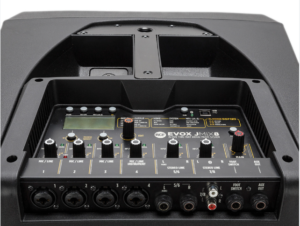
The RCF EVOX JMIX8 is a high-performance active 2-way array PA system. It boasts 1400W of 2-way powered speakers and DSP processing for excellent sound management.
The RCF EVOX JMIX8 combines a powerful 12-inch woofer with a high-output 2.5-inch voice coil, eight ultra-compact 2-inch full-range drivers, and a 1.0-inch voice coil, delivering up to 128dB SPL.
The system includes eight digital inputs, offering a wide range of connectivity options, multiple FX, amp simulators, and remote control functionality. It’s designed for portability and comes with a handy wheeled carry cover.
3. Electro-Voice Evolve 50
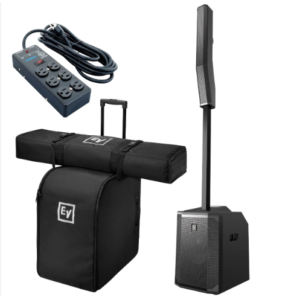
If you’re looking for something compact without compromising on sound quality, the Electro-Voice Evolve 50 is the perfect choice for most mobile DJs.
The system comes with a 12-inch subwoofer topped with a thin column array. With around 1,000 watts of power, it’s a great option for any small venue that needs a little audio boom.
The Evolve 50’s speaker columns feature eight 3.5-inch drivers, each providing 120 degrees of horizontal coverage and 40 degrees of vertical coverage.
This, along with the smaller subwoofer size, makes the Evolve 50 great for smaller venues like your local coffee shop, spin class, or karaoke party!
It’s not the most powerful option on this list, but if you need something small and compact yet still sounds great, the Evo 50 is worth a closer look.
4. Yamaha DZR12
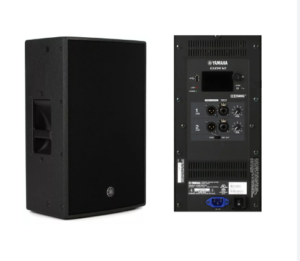
The Yamaha DZR12 is a superb two-way bi-amplified PA speaker with a powerful 2,000-watt Class D amplifier. It delivers a wide frequency range of 39 Hz to 20 kHz and up to 139 dB SPL.
The DZR12 is ideal for both main and stage monitor applications, incorporating sophisticated DSP processing for clear sound and low latency at all volumes.
The speaker features a durable plywood cabinet with a premium-grade polyurea coating and custom transducers for superior sound reproduction.
The flexible design includes a rotatable vertical or horizontal mounting horn, ensuring a variety of setup options.
5. Bose F1 Model 812
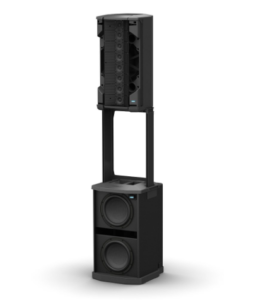
If Bose’s S1 Pro was a great addition, you’ll love the F1 Submission as well. The Bose F1 PA delivers amazing sound even in a very small and compact setup.
It comes with a total of four speakers: two loudspeakers and two subwoofers. Both speakers feature a 1,000-watt array, and the subwoofers both pack 1,000 watts of power.
If you’re looking to do a legitimate event but want a coffee shop-sized speaker, the Bose F1 is the winning option.
Each speaker features eight vertical drivers with custom 100-degree waveguides for consistent, stunning coverage. Both subwoofers feature two 10-inch high-excursion drivers for powerful, floor-shaking bass.
6. Bose S1 Pro+ System
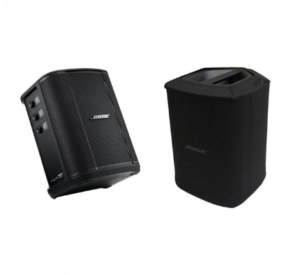
When it comes to game-changing PA speakers, Bose is a leader.
Known for their crisp, hi-fi-style sound, clever ToneMatch technology, and world-class build quality, Bose PA systems are some of the best around, which is why the S1 Pro takes our top spot.
Designed specifically for singer-songwriters, duos, or event speakers, this lightweight, compact speaker system uses a wickedly clever strategy to make the most of its mini size.
First off, the S1 Pro+ can be tilted when placed on the floor to project sound where you need it most, or it can be comfortably placed flat on a table or mounted on a stand for wider coverage.
The first two channels feature combo XLR and 1/4″ inputs, with independent EQ and reverb controls, perfect for acoustic guitars and vocals, while the third channel is dedicated to music playback, with a 3.5mm input or Bluetooth streaming option.
For us, this is a very versatile portable PA system that is built like a tank and is very easy to use and set up.
7. LD Systems Maui 5 Go 100
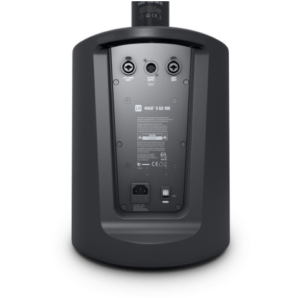
This sleek and modern mini-line array is the latest from LD Systems and has been designed with portability in mind.
The newly designed lithium-ion battery can provide up to 12 hours of continuous operation when used at 98dB, allowing you to play music wherever you are.
The four 3″ neodymium speakers on top of the columns provide fantastic clarity, while the 8″ ferrite subwoofer that acts as the base of the unit delivers plenty of low-end thump.
With a maximum output of 120dB, the Maui 5 Go 100 will certainly be a good fit for many smaller venues, and LD says the Maui can accommodate up to 100 people.
They say it’s perfect for the crowd. Hence the name. So whether you’re looking for a powerful, lightweight system for busking or a low-key PA for small pub gigs, the LD Systems Maui 5 Go 100 is worth considering.
8. Bose L1 Compact Line Array System

The Bose L1 compact system revolutionizes public address with its line array design, ensuring even sound distribution across the stage and audience, even in extreme conditions.
The system uniquely integrates a bass speaker into a powered stand and offers two ToneMatch® channels tuned for microphones and acoustic guitars.
The modular design allows for quick setup in two positions, making it ideal for a variety of room sizes, making it ideal for events ranging from music performances to business presentations.
9. Mackie Thump GO
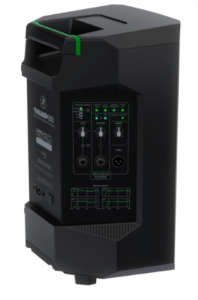
Mackie has long been a trusted name in sound reinforcement, and its running man logo has been a staple in venues around the world.
So whether you’re looking for a cost-effective mixing desk, a complete speaker rig, or in-ear monitors, you’ll find something for you at Mackie.
However, since this guide focuses primarily on the more portable end of the loudspeaker spectrum, we’ve chosen to feature the Mackie Thump Go.
It should be noted that Mackie also offers other options in this category, the FreePlay Live and the SRM-Flex.
Still, the Thump Go is a strong competitor to the popular Bose S1, and we decided to introduce it because it offers superior quality at a more attractive price.
Like the S1, the Thump GO features two independent channels, can run on mains or batteries, and can stream music via Bluetooth.
Setting up the Thump GO for any environment is easier than ever.
Simply choose from four application-specific voice modes—Music, Voice, Monitor, or Sub—and the speaker’s EQ profile will change to better suit the situation at hand, taking all the guesswork out of setting up a new speaker.
10. QSC CP8-8
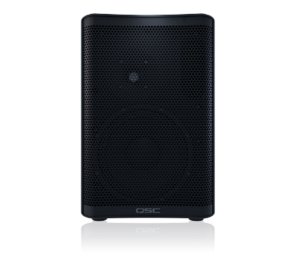
The QSC CP8-8 is a compact powerhouse, featuring a 1000-watt peak power Class-D amplifier for solid, clear sound.
The QSC CP8-8 incorporates advanced DSP with Intrinsic Correction™ for optimal sound quality and speaker protection, while Directivity Matched Transition® (DMT) ensures consistent frequency response throughout the coverage area.
The lightweight and compact design makes it highly portable and suitable for a variety of applications including main PA, stage monitor, or instrument amplifier.
The speaker offers an easy-to-select contour for common applications, enhancing its versatility. Best for Guitarists
11. Roland Cube Street EX
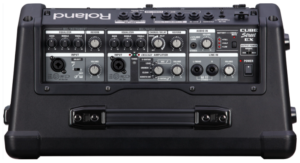
Roland’s portable, battery-powered Cube Street EX PA system features four independent channels for connecting a variety of microphones and instruments,
including your iPhone or iPad, but it seems aimed specifically at busking guitarists, with modeled COSM amp sounds (Clean, Crunch, Lead, and acoustic simulator options for electric guitars, plus a preamp for acoustic guitars).
There’s also a tuner, three-band EQ, and a choice of reverb, chorus, or delay.
The 50W setting delivers maximum power, but there are also quieter 25W and 10W output power modes that conserve battery power. There is also iPhone/iPad recording via i-CUBE LINK and the free CUBE JAM app.
12. LD Systems MAUI 5 GO
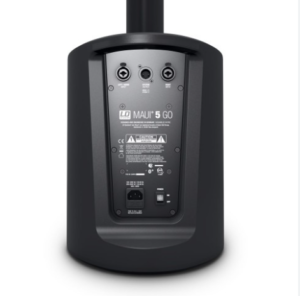
The LD Systems MAUI 5 GO redefines PA system portability with its lightweight, battery-powered column design.
Featuring a 5200 mAh lithium-ion battery, it provides up to 20 hours of continuous operation, making it ideal for outdoor events, street performances, and anywhere with limited access to power.
With 800 watts of peak power, the MAUI 5 GO can easily provide sound to audiences of 100 or more. Weighing just 13 kg, the system is extremely lightweight, and its line array design allows for greater range and coverage.
Features include an integrated 4-channel mixer, Bluetooth® stereo audio streaming, and LD Systems’ Quick-Swap Technology® for virtually unlimited power with easy battery swapping.
13. JBL Pro EON ONE Compact
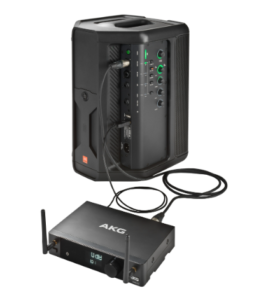
JBL has given us plenty of options with this compact, all-in-one box, which is ergonomically designed for portability and can be installed monitor-style or vertically.
The battery lasts 12 hours and can be charged via an IEC mains socket while the unit is in use.
The four channels are versatile but seem ideal for solo vocalists and guitarists who want to take advantage of the onboard FX.
All are controlled from an iOS or Android app. There’s Bluetooth connectivity and a pair of USB sockets for charging connected mobile devices.
14. Mackie SRM 450
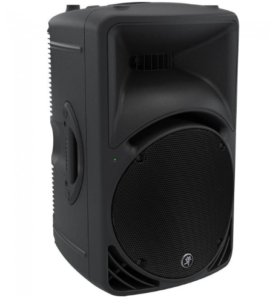
The Mackie SRM 450 combines power, performance, and portability in a durable design, making it a favorite in the live sound industry.
It features a 1000W amplifier with custom transducers. This powered loudspeaker delivers high volume with clarity.
The SRM 450 integrates cutting-edge tools like application-specific speaker modes and an automatic feedback destroyer to simplify optimization for a variety of applications.
The integrated two-channel mixer with Mackie Wide-Z™ input accommodates a variety of sources from mics to guitars without the need for a separate mixer.
What to look for in a portable PA system?
Here are eight key factors musicians should consider when purchasing a new PA system.
01. Portability
Inexperienced musicians may think they need a massive PA system to get professional sound, but in many cases, large speakers can be overkill.
You don’t want to spend too much money on something unnecessarily bulky when there are smaller options available. Portable Bluetooth PA speakers make it easy to perform anywhere.
Soloists don’t have to lug around heavy speakers and tangled wires. Singers who play guitar in bars and restaurants don’t need cumbersome 20-inch speakers.
Instead, consider a lighter speaker that can be easily carried to any location, like the Bose S1 Pro+ portable Bluetooth speaker system.
Portability is also useful in groups. Say you’re in a small band. Instead of bringing your own amplifier, your bassist or keyboardist can plug directly into the PA system.
02. Inputs
Controls and inputs are listed on the back of the Bose S1 Pro+ portable Bluetooth speaker system.
Consider how many instruments and devices you will need to connect to your system on a regular basis. Do you need a mic and a guitar? Or are you looking to connect a four-piece band?
For example, a singer early in his career may only need two inputs, while a garage band may need more.
Some musicians like to have multiple PA systems in their arsenal so they can choose the one that best suits each scenario.
Consider the number of inputs you need and choose the one that is most versatile for the scenario you find yourself in.

03. Power
Large PA systems often plug directly into a wall outlet. This is usually a safe option, as you know that the system will work unless the power goes out at the venue, such as in the event of a storm or a blown fuse.
However, plug-in power is often not necessary.
Portable Bluetooth speakers can outlast your vocal cords without the need for an electrical cord. The rechargeable battery in the Bose S1 Pro+ portable Bluetooth speaker system lasts up to 11 hours, giving musicians plenty of time to put on a great show.
Wireless is also essential when there is no electrical power, such as when busking.
If you want to jam on the sidewalk and collect tips, a battery-powered PA is a good choice.
For larger outdoor venues, such as concerts in a park, you may have the option to plug into a generator, but the noise from the generator can overshadow the music, so batteries can be useful as well.
04. Mixing Features
Some musicians opt for an eight-channel mixer, but you can purchase an updated portable PA system with built-in mixing capabilities.
If mixing is a big priority, you can choose a mixer and download a variety of apps to tweak your tone and sound.
Or, you can choose a portable Bluetooth PA speaker that handles basic settings like treble and effects like reverb and delay.
Bands often need powerful mixing options, such as the ability to turn up the bass when other instruments are overwhelming the sound, or to turn down the lead guitar a notch during a particularly intense solo riff.
While mixing used to be entirely analog, leaving the knobs and faders behind for integrated wireless mixing options can make mixing much simpler.
05. Latest Technology
Like the phone in your pocket, the technology inside a PA system improves over time.
While musicians naturally tend to focus on sound quality, they also consider how certain features can make the technical aspects of their work easier, allowing them to focus on delivering the best possible performance.
Bluetooth connectivity allows you to connect headphones to your PA system for mixing and quality control. This is useful if you are playing in a crowded venue.
Without Bluetooth, your voice can be drowned out by audience chatter, clinking glasses, and doors opening and closing. With a Bose transmitter (sold separately), you can connect your microphone and instruments to the S1 Pro+ portable Bluetooth speaker system, allowing you to move around the stage with ease.
Remote control via the Bose Music app can help you adjust tone and sound without having to bend your PA system.
This type of flexibility gives you the freedom to make adjustments on the fly to optimize the audience experience.
Also, consider optional accessories. Are you going old-school with wired accessories, or is a wireless microphone your top priority?
Make sure your accessories are compatible with your PA system and have a reliable connection with a wide enough range to comfortably move around the stage.
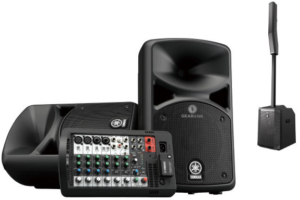
06. Ease of Use
An intuitive, easy-to-use system allows you to focus on your craft.
If you grew up with analog gear, there may be a learning curve to using a digital app to control your PA system, but its capabilities really do offer benefits that will help you advance the technical side of your music.
If you’re playing in a bar, you’ll want to avoid having to jostle your guests as you walk into the venue with your arms full of gear.
Having a portable system that you can carry around with you can set up in minutes, saving you time and stress. A plug-and-play style system makes the setup process easier for you, your band, and your audience.
07. Durability
Since longevity is important, you need to choose a durable system that will last a long time.
Of course, musicians want to be careful with their equipment, but the nature of portable systems means that they are often transported to different locations.
Quality materials and thoughtful design can make the difference between a speaker that dies after a few months and one that lasts for years.
08. Price
Every musician has a different budget and needs for a PA system. Your resources and needs may also change over the course of your career.
You may want to buy the cheapest option possible at the beginning. However, as your cheap system wears out and your career grows, you may choose to invest in higher-quality gear.
PA systems vary in price. More basic gear can cost as little as a few hundred dollars, while sophisticated commercial systems can cost thousands.
Consider all other factors when it comes to cost to make sure you’re getting the best value.
Major Types of PA Systems
1. Ceiling
Ceiling PA systems are commonly used in indoor settings such as schools, offices, and shopping centers. They consist of several small speakers mounted on the ceiling, distributing sound evenly throughout the space.
This setup is ideal for background music and announcements, as it can cover a large area without being distracting.
2. Wall
Wall-mounted PA systems are another type and are a popular choice, especially in places where ceiling installation is not possible or desirable. The speakers are mounted on the wall, allowing for more precise sound projection, allowing for greater control over the audio experience.
This type is often used in restaurants, small venues, and conference rooms where clear sound projection is required from a specific point.
3. Outdoor
Outdoor PA systems are designed to be weather-resistant and deliver clear sound in larger, more open spaces. They include durable, weather-resistant speakers with higher output to overcome background noise.
Outdoor systems are ideal for events, public gatherings, and places where clear, loud sound is important, such as parks or sports stadiums.
FAQs
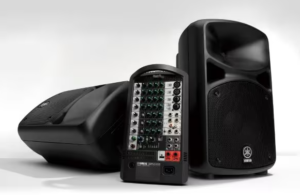
How does a PA system work?
PA (Public Address) systems amplify sound so that it can be heard over a wide area or by a large audience.
They work by using microphones to convert the sound into an electrical signal, amplifying it through a power amplifier, and then converting it back into sound through speakers.
These systems often include a mixer and processor to easily adjust and tailor the sound to your specific needs, ensuring clarity and appropriate volume levels for your audience.
Do I need a subwoofer with my PA speakers?
Whether or not you need a subwoofer with your PA speakers depends on your application.
For music events with a strong bass, such as house music, a subwoofer is essential to deliver a full range of sound. For speech-only events, a tower alone may suffice.
Should I buy an amplifier or a PA?
Choosing between an amplifier and a PA system depends on your needs. An amplifier is ideal for amplifying instruments in smaller setups or venues.
A PA system, which may include an integrated amplifier[2], is designed for vocal amplification and larger audiences, providing more inputs and versatility.
How powerful should a PA system be?
The power required for a PA system will depend on the size of the venue and the number of people in it.
Smaller venues and gatherings generally require less power, while larger venues require higher wattage to ensure clear, distortion-free sound.
What should the sound level of a PA system be?
The sound level of a PA system should be adjusted depending on the type of event and the size of the venue.
It should be loud enough for the audience to hear without feeling uncomfortable. For most events, a level that allows easy conversation with the audience is ideal.
Also read: 10+ Best Digital Mixing Boards in 2025
